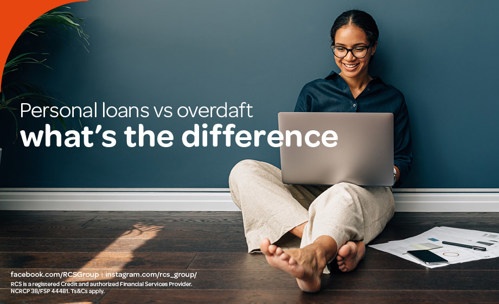Personal Loan vs Overdraft | What's the difference?
11 AUGUST 2023
Personal loans are the most popular method of borrowing money, compared to overdrafts. Choosing the best method of credit can be tricky. Both have their advantages and disadvantages, according to their use. Use this guide to determine which is the best option for you.
What is a personal loan?
A loan is a fixed amount of money that is borrowed over a period that needs to be paid back in monthly instalments after the time ends. This money is borrowed from lenders that also issue an interest rate on the amount you take out, which over time is the lenders’ profit. A personal loan is a loan that can be used for a variety of purposes, from a down payment towards a mortgage to paying for a much-needed vacation. Your approval and loan terms for a personal loan depend on your credit score and credit history.
Terms you need to know to understand personal loans;
- Principal amount: The original amount you borrow from the lender.
- Interest rate: Interest accumulates over time according to this rate which is paid on top of the principal amount. Read more about how personal loan interests are calculated.
- Loan term: The set amount of monthly installments and months that you have to repay the loan.
- Unsecured vs. secured: Personal loans are most often unsecured, meaning you don’t need to have an asset as collateral against your loan.
Advantages of having a personal loan
- A fixed interest rate means that it cannot go up and have you paying more than what you expected.
- A fixed principal amount so that you’re not tempted to overspend.
- Fixed monthly payments making repayment easy.
Disadvantages
- You need to apply for another loan if you need additional funds, as you’re not able to borrow on top of an existing loan.
- Missing payments negatively impact your credit score by lowering it, which can affect future applications.
- There could be expensive repayment charges.
What is an overdraft facility?
An overdraft facility is a credit facility that exists as an attachment to your current transactional account. It functions as an agreement between you and the lender where you are allowed to spend over what is in your bank account. How much overdraft is available is dependent on your bank balance and your income. To have access to an overdraft facility, you will need to open an account with a bank that offers the service. Once you’ve applied and it is approved, the overdraft is always there whenever you need it.
What you need to know to understand overdrafts
- Ease of usage: It is only activated when used, so you can spend more than your available balance.
- Maximum limit: There is a max limit on top of your overdraft facility, which is usually the amount you pay for.
- Repayment method: You repay your overdraft as money comes into your account.
Advantages of using an overdraft facility
- You can’t miss a payment on an overdraft as the money is already available and is being paid for as money comes into your account.
- Unexpected costs can be dealt with immediately with an overdraft once you’ve been approved for it.
- There is no repayment term, so you can pay it back when you can.
Disadvantages
- Overspending is easier to do with an overdraft as the funds are always available.
- Variable interest rates can mean that the interest can increase and thus increase how much you need to pay.
- You need a really good credit score to qualify for an overdraft.
- Because the overdraft facility is connected to your account, negative balances are automatically paid for by money coming in.
- An overdraft offers a lower amount to use than a personal loan.
What is the difference between an overdraft and a personal loan?
Availability
To have access to a personal loan you need to make sure you have a good credit score and credit payment history. Once approved, you have a set amount to use and a certain amount of time to repay. To take out another personal loan, you will need to go through the process again. With an overdraft facility, depending on if your bank account has the service, you apply once and the overdraft stays open for you to use whenever needed.
Interest rate
With a personal loan, your interest rate is pre-determined and added to your loan amount. Overdraft interest rates are usually higher than personal loans. If you don’t withdraw any money from your overdraft, no interest is charged.
Credit limit
When taking out a personal loan, the loan amount is set after agreeing with your lender. After this, loan terms can’t be changed. However, with an overdraft, you’re able to withdraw any amount that you need.
Repayment
An overdraft facility allows you to repay the credit whenever you want as it is always attached to your account. For a personal loan, you agree to repay the loan after a certain time. If you want to repay your loan in full before the loan term is over, you might have to pay pre-payment fees. Repaying the overdraft amount does not incur any extra fees.
Which is the best option?
The answer to this question is almost entirely dependent on why you are needing to use credit. If you find yourself running out of cash by month-end, or needing money to cover an urgent payment; an overdraft facility might be the best option for you. If you need to borrow a larger amount to fund larger expenses, like car repairs or home improvements, a personal loan would be better suited. Using a loan to repay an overdraft facility or the other way around, could leave you with debt that you’re unable to pay. Before choosing either a personal loan or an overdraft, make sure that you are financially stable enough to meet repayment requirements.
MORE ARTICLES ABOUT
RELATED ARTICLES

Education
28 AUGUST 2025
SA Research: How Parents Impact a Child’s Financial Intelligence

Education
12 JUNE 2025
Cultivating Tomorrow's Leaders: Equipping Young South Africans for Life’s Challenges

Education
28 MARCH 2025
